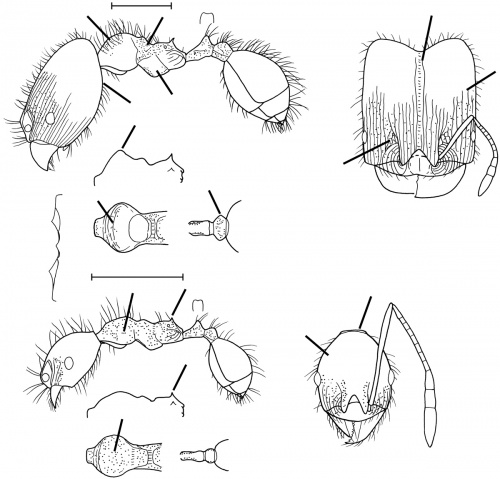Pheidole peruviana
| Pheidole peruviana | |
|---|---|
| Scientific classification | |
| Kingdom: | Animalia |
| Phylum: | Arthropoda |
| Class: | Insecta |
| Order: | Hymenoptera |
| Family: | Formicidae |
| Subfamily: | Myrmicinae |
| Tribe: | Attini |
| Genus: | Pheidole |
| Species: | P. peruviana |
| Binomial name | |
| Pheidole peruviana Wilson, 2003 | |
Nothing is known about the biology of peruviana.
Identification
See the description in the nomenclature section.
Keys including this Species
Distribution
Only known from the type locality.
Latitudinal Distribution Pattern
Latitudinal Range: -0.631944444° to -12°.
| North Temperate |
North Subtropical |
Tropical | South Subtropical |
South Temperate |
- Source: AntMaps
Distribution based on Regional Taxon Lists
Neotropical Region: Ecuador, Peru (type locality).
Distribution based on AntMaps
Distribution based on AntWeb specimens
Check data from AntWeb
Countries Occupied
| Number of countries occupied by this species based on AntWiki Regional Taxon Lists. In general, fewer countries occupied indicates a narrower range, while more countries indicates a more widespread species. |

|
Estimated Abundance
| Relative abundance based on number of AntMaps records per species (this species within the purple bar). Fewer records (to the left) indicates a less abundant/encountered species while more records (to the right) indicates more abundant/encountered species. |

|
Biology
Castes
Nomenclature
The following information is derived from Barry Bolton's Online Catalogue of the Ants of the World.
- peruviana. Pheidole peruviana Wilson, 2003: 731, figs. (s.w.) PERU.
Unless otherwise noted the text for the remainder of this section is reported from the publication that includes the original description.
Description
DIAGNOSIS Similar in various traits to Pheidole amata, Pheidole ambigua, Pheidole celaena, Pheidole fera, Pheidole germaini, Pheidole rutilana, Pheidole schwarzmaieri, Pheidole superba and Pheidole vomer, differing as follows.
Major: reddish yellow; head in side view with strongly convex venter and weakly convex dorsum, tapering strongly toward occiput, and in full-face view subrectangular, somewhat elongate, with straight sides; small patch of rugoreticulum present just posterior to antennal fossa on each side; remainder of anterior half of head dorsum mostly carinulate, and posterior half smooth and shiny; humeri in dorsal-oblique view raised as prominent lobes; anterior third of pronotal dorsum carinulate and remainder of promesonotal dorsum smooth, as well as lower half of mesopleuron; postpetiole from above diamond-shaped.
Minor: occiput strongly narrowed, with nuchal collar; all of head posterior to eyes smooth; all of mesosoma foveolate; propodeal spines small and vertical on the propodeal basal face.
MEASUREMENTS (mm) Holotype major: HW 1.80, HL 2.10, SL 0.86, EL 0.22, PW 0.88. Paratype minor: HW 0.60, HL 0.72, SL 0.86, EL 0.12, PW 0.42.
COLOR Major: concolorous reddish yellow.
Minor: concolorous plain medium yellow.
Figure. Upper: holotype, major. Lower: paratype, minor. Scale bars = 1 mm.
Type Material
Type Locality Information
PERU: Estácion Biologia de Cocha Cashu, Manu National Park, Madre de Dios, 400 m, col. Diane W. Davidson.
Etymology
Named after the country of origin of the type colony.
References
- Wilson, E. O. 2003. Pheidole in the New World: A dominant, hyperdiverse ant genus. Harvard University Press, Cambridge, MA. Text and images from this publication used by permission of the author. (page 731, fig. major, minor described)
References based on Global Ant Biodiversity Informatics
- Alonso L., M. Kaspari, and A. Alonso. 2001. Assessment of the Ants of the Lower Urubamba Region, Peru. Pp 87-93. In: Alsonso A, Dallmeier F, Campbell P, editors. Urubamba: The biodiversity of a Peruvian rainforest. SI/MAB Biodiversity Program-Smithsonian Institution. 204 p.
- Fernández, F. and S. Sendoya. 2004. Lista de las hormigas neotropicales. Biota Colombiana Volume 5, Number 1.
- Ryder Wilkie K.T., A. L. Mertl, and J. F. A. Traniello. 2010. Species Diversity and Distribution Patterns of the Ants of Amazonian Ecuador. PLoS ONE 5(10): e13146.doi:10.1371/journal.pone.0013146
